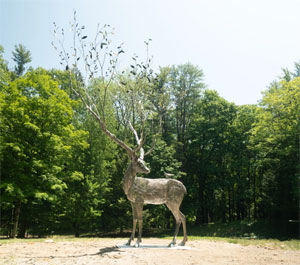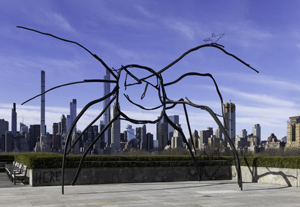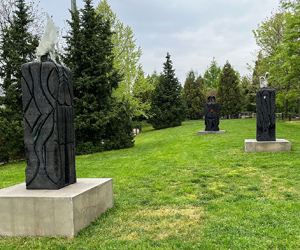8.23.24 — The Greening of Harlem
For at least six months, Harlem becomes a garden. At the very least it welcomes one, only not with flowers.
With Harlem Sculpture Gardens, from May through October, its parks become one long sculpture garden, with echoes all across the west side. The West Harlem Art Fund, NY Artist Equity, and community curators invite nineteen artists into three strips of playgrounds and greenery.  And you can see them as a garden, from the lake and willow trees at its south to denser woods on every side. Sculpture will soon be gone, but Harlem may never look the same again.
And you can see them as a garden, from the lake and willow trees at its south to denser woods on every side. Sculpture will soon be gone, but Harlem may never look the same again.
Or so they hope, for change comes slowly, and even now the visitor in search of art may feel like a pioneer. The show feels thrown together on the cheap, with neither maps, photos, nor closing dates on its Web site and signs fallen away. If you cannot find the half of it, and I did not, you can still get better acquainted with the neighborhood. Just to see kids ascending a red, free-form jungle gym would be worth a trip to Morningside Park. To recognize the dignity and diversity of the community should be a requirement for all New Yorkers. If the art is largely detached and disappointing, that has its lessons as well.
When you think of Harlem, a garden may not come to mind. You may think first of a cultural history that did not end with the Harlem Renaissance and the stateliness of Strivers Row, concrete and crime, family histories, or racism and neglect. New York summer sculpture has come before to Marcus Garvey Park across town—featuring Simone Leigh, Maren Hassinger, and “InHarlem,” a home for local artists curated by the Studio Museum in Harlem. Those with long memories will take pride in the protests that blocked Columbia University from appropriating Morningside Park on behalf of a gym. They could not rescue the park from what were to be New York’s darkest decades. Yet the greenery is there.
That park, St. Nicholas Park, and Jackie Robinson Park add up to add up to practically a single landscape running a block wide and forty-five blocks long. Each rests on a cliff or terrace with a single long path below, making it a bit easier to find the art. Morningside Park, by far the lushest, accounts for the name of Columbia’s neighborhood, Morningside Heights. It has never looked half so open. A rec center easily upstages Jackie Robinson Park, which comes to a dead end in a rail overpass and stairs that you may hesitate to climb. Still, you can appreciate the art all the more should you find it.
Harlem Sculpture Gardens treats long-term sculpture outside the park, at City College and in plazas, as just part of the show. Three alone suggest the problems and potential of public art. Gabriel Koren and Algernon Miller serve up a monument to Frederick Douglass at the northwest corner of Central Park, outshone by triangular slabs for benches and a star chart caved into a black wall. A mile or so north, Alison Saar animates a statue of Harriet Tubman with an easy stride, a train of bronze behind her, and hands, feet, and symbols etched in her clothing and base. Richard Hunt, always at his best outdoors, has his usual elegance just west on 125th Street. Do not blame him if his claim to a uniquely black abstraction looks an awful lot like a bunker.
Public sculpture will always have a slightly defensive posture. If things loosen up with emerging artists in the parks, they still seem obliged to learn from the past. They are good students. Intersecting red steel loops by Miguel Otero Fuentes could have come from any of a dozen artists fifty years ago. Weathered steel from Michael Poast brings the rough edges of the city to David Smith. Steel for Iliana Emilia Garcia extends vertically, and it may take a moment to realize that it forms literal high chairs.
Each is adapting late modern sculpture to experience. For Carole Eisner, that means turning Smith’s welded planes into a mother and child, in bright yellow. For Zura Bushurishvili, it means lending a tall, gaunt man out of Alberto Giacometti the specificity of a village elder. What they cannot do is reach out to politics or community. If your image of Harlem is bullet-ridden, Margaret Roleke has a colorful screen of shotgun shells, Felipe Jacome and Svetlana Onipko a ballerina of bullet casings. Mine, I hope, is not. Still, the work looks good, and Roleke’s could pass for early interactive art by Daniel Rozin that flipped its shafts to mirror the viewer’s shadow.
When they do reach out, it is to their immediate surroundings. This is not site-specific art, but it takes much of its materials and imagery from the parks. That includes tree stumps and twigs from Jaleeca Yancy, a single curve of branches connecting aluminum on polished wood from Dianne Smith as Echoes of the Path, and a deer with branches instead of antlers by ByeongDon Moon. I Dream of Being a Tree, its title goes, and all in a way are dreamers. I am sorry that I cannot mention more of them. With luck, the gardens will return next year, with more professionalism and adventure.
Read more, now in a feature-length article on this site.

